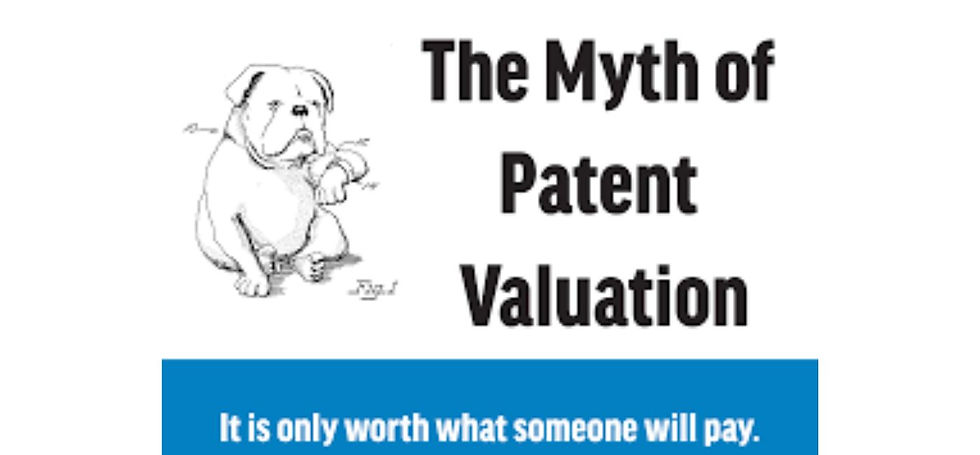Patent Valuation Myths That Could Cost Companies Millions In 2025
- Gaurav Khandelwal
- Sep 27
- 3 min read
Updated: Oct 31

Introduction
In Canada’s fast‑paced innovation ecosystem, many organizations overestimate or misjudge their intellectual property worth. Misconceptions about patent valuation myths regularly lead to serious consequences. Companies assuming guaranteed value from their patent portfolios risk unexpected financial setbacks. In 2025, evolving markets, shifting regulations, and rising competition magnify exposure. This article uncovers five dangerous myths that could cost firms millions, clarifying how to protect their IP assets and leverage high‑value patents smartly.
Myth #1: All Patents Automatically Deliver High Value
Some executives believe any patent grants immediate competitive advantage. That myth undermines strategic planning. Patents differ tremendously according to claims, enforceability, geographic coverage, and commercial relevance. Just because an entity owns a patent doesn’t guarantee revenue streams. Effective valuation depends on market demand, infringement likelihood, lifespan, and legal strength. Without careful analysis, companies endure business loss IP that cannot be monetized.
Myth #2: Patent Valuation Remains Constant Over Time
Technology sectors evolve fast. What once seemed revolutionary may lose appeal within months. Expecting valuation stability invites massive losses. Legal validity can falter through prior art discoveries or regulatory changes. Market shifts may render inventions obsolete. Therefore, professional valuators must reassess high‑value patents periodically. Transparent appraisal using up‑to‑date financial models prevents overvaluation and surprises.
Myth #3: Comparable Sales Alone Determine Worth
Relying exclusively on licensing deals or recent sales of similar patents misleads many. Comparable transactions rarely capture full context: jurisdictional differences, field variations, unique claim structures. Such data might ignore emerging sectors where transactional comparables do not yet exist. Relying on those alone distorts perceived value. Blending cost‑based, income‑based, and market‑based approaches yields richer, more accurate perspectives on patent valuation myths.
Myth #4: Internal R&D Cost Equals Patent Value
Some assume that development expenditures directly translate into worth. That calculation ignores whether invention enjoys market adoption. R&D costs reveal investment size, not commercial potential. Even heavily funded research may produce niche or unneeded features. Firms often pay for innovation that buyers won’t purchase. Thus, valuation models must incorporate demand forecasts, regulatory risks, production costs, and competitive obstacles to mitigate business loss Intellectual Property.
Myth #5: Strong Patent Portfolio Guarantees Licensing Revenue
Many count on licensing income as reliable return on patent investments. Reality proves far more complex. Licensing requires negotiation, enforcement, and counter‑claims. Enforcement legal costs often erode revenue. Potential infringers might resist or contest validity. Moreover, global enforcement becomes costly across borders. Instead of assuming licensing money will flow, smart companies evaluate enforcement likelihood, overlapping patents, and defensive strategies. Building robust litigation infrastructure enhances chances for compensation and realization of high‑value patents.
Why These Myths Matter in 2025

Innovators and investors in Canada face intensified pressure. Artificial intelligence, biotech, clean energy disrupt traditional IP landscapes. Policymakers tighten patent examination processes. Market players demand faster proof of utility and enforceability. When firms cling to myths, they overlook critical risk factors: invalidation, regulatory non‑compliance, poor commercialization strategy. Such oversights trigger business loss IP and diminish competitive opportunities, causing millions in lost value.

Hire Expert Valuators: Specialists with domain‑specific experience assess enforceability, market potential, and erosion risks.
Utilize Multiple Valuation Methods: Combine income, cost, and market approaches; stress‑test assumptions.
Monitor Legal & Market Developments: Observe case‐law rulings, patent office policies, industry disruptions.
Engage in Scenario Planning: Model best, moderate, and worst‑case outcomes for high‑value patents.
Integrate Patent Strategy with Business Strategy: Align inventions with commercial roadmaps; avoid holding patents without actionable routes to market.
Implications for Canadian Companies

Enterprises headquartered in Ontario, Québec, British Columbia, and beyond must keep vigilance. Accessing legal counsel early prevents defects that damage enforceability. Filing patents across jurisdictions strengthens protection but increases cost; firms must decide where value truly lies. Investors demanding due diligence expect transparent metrics around patent valuation myths and evidence against overpricing. Failing to comply may hamper financing or exit transactions.
Conclusion
Misunderstanding patent valuation myths continues to wreak havoc on corporate bottom lines. Canada’s innovators must sidestep assumptions: not all patents translate into profit, valuation doesn’t stay fixed, comparable sales aren’t sufficient, R&D costs don’t equal worth, and portfolios don’t guarantee licensing revenue. Acting proactively saves millions. Companies embracing rigorous valuation methods, legal precision, and strategic alignment protect against business loss IP and realize genuine value from high‑value patents.
.png)










Comments